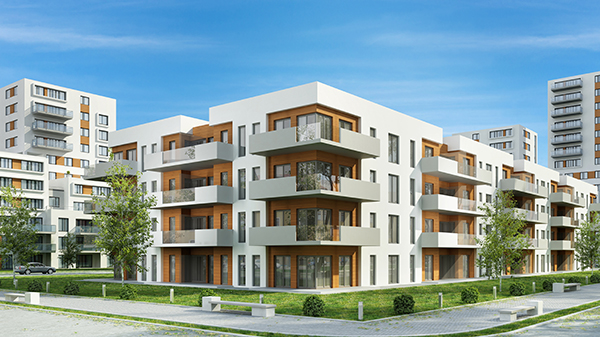Many real estate investors choose to own multiple single-family rentals (SFR) instead of investing in multifamily properties, or apartments. While the viewpoint is that single family is simpler; in many ways, multifamily makes more sense.
When you invest in SFRs you might see roughly $200/month in cashflow when you take in your rents and cover your costs. Well, the same math works in multifamily. For my portfolio, I generally average $200-250 per unit in cashflow. There are exceptions to the $200/month in single family, but the same is true for multifamily. Even if single family does perform better on a cashflow basis, there are many reasons to make the move to multifamily.
1. Speed
You can buy 50-100 units with one transaction as opposed to one transaction per house. How long would it take you to buy 10 houses? A realistic timeline would be 5-10 years for some but even if you were to somehow do it in one year, you are likely going to go through the loan process 10 different times.
When investing in multifamily properties, you can buy 20, 50 or even over 100 units in one transaction. How much easier is that? One credit pull, one time to submit all your documents to the lender, and one closing!
2. Scale
If you have a large portfolio of singles-family rentals (e.g.,10) you are either managing them all yourself or paying a management company roughly 10 percent of the rent to manage them for you. While 10 percent doesn’t sound like much, you have to consider the average profit on $1,000 rent would be about $200/month or $2,400 per year in most markets. If you are paying someone 10 percent of the rent to manage it for you then that is $1,200 for the year which is six months profit or half of your annual profit.
With a 40-50 unit you should be able to afford a part-time manager to handle it for you, which is part of your operating budget for the property. At the end of the month, your profit is yours as your payroll (management) was covered in the expenses in the monthly budget.
The scale of multifamily allowed me to hire someone to handle the day-to-day operations of the business freeing me up to find the next deal and meet the next potential investor.
3. Valuation of the Asset
When you buy commercial real estate/multifamily, your value is based upon the profit of the property, unlike single family, which is valued on a comparable sales (comp) basis.
When you buy or sell a single-family home, either as an investment property or your personal residence, the value is set by looking at what other similar properties in the neighborhood have sold for. This establishes the value of your home.
Multifamily, on the other hand, is valued based on its profitability or the income approach. The higher the profit, the higher the value. This is because multifamily is seen as a business and is thus valued on the amount of profit or cashflow it will generate.
This leads to tremendously larger upside in multifamily. If my property is 50 percent more profitable than the same size, type, and age of property owned by my competitor across the street, then my property is worth 50 percent more.
4. Lending Is Much Easier in Multifamily
For single family, the basics are that you will need to keep your DTI (debt-to-income) in line each time you purchase a house. Additionally, if you are self-employed, it might be more difficult to get a mortgage. The lender is going to want to see W2 income and your DTI as a rule will need to be roughly 43 percent.
When you buy commercial real estate, your lender will provide a loan based in large part on the property’s ability to pay or cover its own debt service (principal and interest). The higher the profit from the property, the more loan they are willing to provide—up to about 80 percent in today’s market.
To illustrate this point, I paid all cash for my personal residence in 2010 because I was following the dogma of “debt is evil.” Once I got educated in commercial real estate, I realized that I should not have paid cash and should have gone to my bank to take out an 80 percent loan on the property that I owned free and clear. The banker basically laughed at me because I didn’t have a job (I had retired the previous year). My only option to unlock all of that “dead” equity in my house was to sell and move into a rental myself. Nine months later, I bought my first apartment complex for 1.6M with a shiny new loan of $1,137,000 and still with no job!
5. Easier to Manage
Compare two different real estate portfolios, one consisting of five single-family rentals and one with a 100-unit apartment complex. For the person with five single-family properties, they will likely be driving all over town to manage the showings, maintenance, inspections, etc. That investor has just bought him/herself a JOB!
The investor who has the 100-unit apartment complex has all 100 units under one roof, which doesn’t require moving around the city to manage it.
6. Safer and More Consistent
If you own a couple of houses and have one vacancy, you are 50 percent vacant, which chops your income and potential profit in half until you get it re-leased. With 100 units, 10 vacant still leaves 90 contributing rent and profit.
Many naysayers argue that they don’t have the money or know-how to invest in multifamily.
Remember when you bought your first rental house? You didn’t really know what you were doing then either, but you learned what you needed to and now are proficient. The same will happen in multifamily if you are open to learning and breaking out of your comfort zone to follow a proven path. When you combine the benefits of multifamily investing with the ability to raise money, you would be amazed at how different things can be for you and your family.
Known in the real estate world as the Apt-GuySM, Bruce Petersen is a serial syndicator who started with a 48-unit building and has now syndicated over 1,100 units. As the founder and CEO of Bluebonnet Asset Manager LLC and Bluebonnet Commercial Management, Bruce is a #1 Best Selling Author and has received local and national recognition for his syndication efforts. He was the recipient of the Austin Apartment Association’s Independent Rental Owner of the Year for 2016 and the National Apartment Association’s Independent Rental Owner of the Year for 2017. In addition to being a TV personality and public speaker, Bruce is also an educator with a focus in multifamily investing and syndicating.
























0 Comments